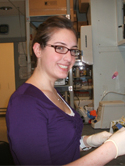Distinct roles of RZZ and Bub1-KNL1 in mitotic checkpoint signaling and kinetochore expansion Journal Article
| Authors: | Rodriguez-Rodriguez, J. A.; Lewis, C.; McKinley, K. L.; Sikirzhytski, V.; Corona, J.; Maciejowski, J.; Khodjakov, A.; Cheeseman, I. M.; Jallepalli, P. V. |
| Article Title: | Distinct roles of RZZ and Bub1-KNL1 in mitotic checkpoint signaling and kinetochore expansion |
| Abstract: | The Mad1-Mad2 heterodimer is the catalytic hub of the spindle assembly checkpoint (SAC), which controls M phase progression through a multi-subunit anaphase inhibitor, the mitotic checkpoint complex (MCC) [1, 2]. During interphase, Mad1-Mad2 generates MCC at nuclear pores [3]. After nuclear envelope breakdown (NEBD), kinetochore-associated Mad1-Mad2 catalyzes MCC assembly until all chromosomes achieve bipolar attachment [1, 2]. Mad1-Mad2 and other factors are also incorporated into the fibrous corona, a phospho-dependent expansion of the outer kinetochore that precedes microtubule attachment [4–6]. The factor(s) involved in targeting Mad1-Mad2 to kinetochores in higher eukaryotes remain controversial [7–12], and the specific phosphorylation event(s) that trigger corona formation remain elusive [5, 13]. We used genome editing to eliminate Bub1, KNL1, and the Rod-Zw10-Zwilch (RZZ) complex in human cells. We show that RZZ's sole role in SAC activation is to tether Mad1-Mad2 to kinetochores. Separately, Mps1 kinase triggers fibrous corona formation by phosphorylating two N-terminal sites on Rod. In contrast, Bub1 and KNL1 activate kinetochore-bound Mad1-Mad2 to produce a “wait anaphase” signal but are not required for corona formation. We also show that clonal lines isolated after BUB1 disruption recover Bub1 expression and SAC function through nonsense-associated alternative splicing (NAS). Our study reveals a fundamental division of labor in the mammalian SAC and highlights a transcriptional response to nonsense mutations that can reduce or eliminate penetrance in genome editing experiments. Rodriguez-Rodriguez et al. identify distinct roles for Bub1, KNL1, and RZZ in SAC signaling and fibrous corona formation. They also show that BUB1-disrupted clones re-express Bub1 and regain SAC function via nonsense-associated alternative splicing, an often-overlooked transcriptional response that can limit penetrance in genome editing experiments © 2018 Elsevier Ltd |
| Keywords: | cell division; aneuploidy; chromosome segregation; spindle assembly checkpoint; gene editing |
| Journal Title: | Current Biology |
| Volume: | 28 |
| Issue: | 21 |
| ISSN: | 0960-9822 |
| Publisher: | Cell Press |
| Date Published: | 2018-11-05 |
| Start Page: | 3422 |
| End Page: | 3429.e5 |
| Language: | English |
| DOI: | 10.1016/j.cub.2018.10.006 |
| PUBMED: | 30415700 |
| PROVIDER: | scopus |
| PMCID: | PMC6522255 |
| DOI/URL: | |
| Notes: | Article -- Export Date: 3 December 2018 -- Source: Scopus |
Altmetric
Citation Impact
BMJ Impact Analytics
MSK Authors
-
 34
34Jallepalli -
 35
35Maciejowski -
 2
2Corona -
 1
1Lewis
Related MSK Work




